Adult stage gamma-globin silencing is mediated by a promoter direct repeat element
- PMID: 15831451
- PMCID: PMC1084292
- DOI: 10.1128/MCB.25.9.3443-3451.2005
Adult stage gamma-globin silencing is mediated by a promoter direct repeat element
Abstract
The human beta-like globin genes (5'-epsilon-Ggamma-Agamma-delta-beta-3') are temporally expressed in sequential order from the 5' to 3' end of the locus, but the nonadult epsilon- and gamma-globin genes are autonomously silenced in adult erythroid cells. Two cis elements have been proposed to regulate definitive erythroid gamma-globin repression: the DR (direct repeat) and CCTTG elements. Since these two elements partially overlap, and since a well-characterized HPFH point mutation maps to an overlapping nucleotide, it is not clear if both or only one of the two participate in gamma-globin silencing. To evaluate the contribution of these hypothetical silencers to gamma-globin regulation, we generated point mutations that individually disrupted either the single DR or all four CCTTG elements. These two were separately incorporated into human beta-globin yeast artificial chromosomes, which were then used to generate gamma-globin mutant transgenic mice. While DR element mutation led to a dramatic increase in Agamma-globin expression only during definitive erythropoiesis, the CCTTG mutation did not affect adult stage transcription. These results demonstrate that the DR sequence element autonomously mediates definitive stage-specific gamma-globin gene silencing.
Figures
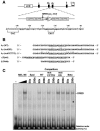

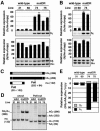

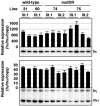
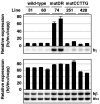
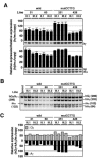
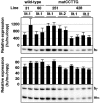
Similar articles
-
Genome architecture of the human beta-globin locus affects developmental regulation of gene expression.Mol Cell Biol. 2005 Oct;25(20):8765-78. doi: 10.1128/MCB.25.20.8765-8778.2005. Mol Cell Biol. 2005. PMID: 16199858 Free PMC article.
-
Juxtaposition of the HPFH2 enhancer is not sufficient to reactivate the gamma-globin gene in adult erythropoiesis.Hum Mol Genet. 2005 Oct 15;14(20):3047-56. doi: 10.1093/hmg/ddi337. Epub 2005 Sep 9. Hum Mol Genet. 2005. PMID: 16155112
-
DNase I hypersensitivity and epsilon-globin transcriptional enhancement are separable in locus control region (LCR) HS1 mutant human beta-globin YAC transgenic mice.J Biol Chem. 2010 May 7;285(19):14495-503. doi: 10.1074/jbc.M110.116525. Epub 2010 Mar 15. J Biol Chem. 2010. PMID: 20231293 Free PMC article.
-
Role of intergenic human gamma-delta-globin sequences in human hemoglobin switching and reactivation of fetal hemoglobin in adult erythroid cells.Ann N Y Acad Sci. 2005;1054:48-54. doi: 10.1196/annals.1345.057. Ann N Y Acad Sci. 2005. PMID: 16339651 Review.
-
Silencing and activation of embryonic globin gene expression.Ann N Y Acad Sci. 1998 Jun 30;850:70-9. doi: 10.1111/j.1749-6632.1998.tb10464.x. Ann N Y Acad Sci. 1998. PMID: 9668529 Review.
Cited by
-
Genome architecture of the human beta-globin locus affects developmental regulation of gene expression.Mol Cell Biol. 2005 Oct;25(20):8765-78. doi: 10.1128/MCB.25.20.8765-8778.2005. Mol Cell Biol. 2005. PMID: 16199858 Free PMC article.
-
PGC-1 coactivator activity is required for murine erythropoiesis.Mol Cell Biol. 2014 Jun;34(11):1956-65. doi: 10.1128/MCB.00247-14. Epub 2014 Mar 24. Mol Cell Biol. 2014. PMID: 24662048 Free PMC article.
-
Fetal globin gene repressors as drug targets for molecular therapies to treat the β-globinopathies.Mol Cell Biol. 2014 Oct 1;34(19):3560-9. doi: 10.1128/MCB.00714-14. Epub 2014 Jul 14. Mol Cell Biol. 2014. PMID: 25022757 Free PMC article. Review.
-
Nuclear receptors TR2 and TR4 recruit multiple epigenetic transcriptional corepressors that associate specifically with the embryonic β-type globin promoters in differentiated adult erythroid cells.Mol Cell Biol. 2011 Aug;31(16):3298-311. doi: 10.1128/MCB.05310-11. Epub 2011 Jun 13. Mol Cell Biol. 2011. PMID: 21670149 Free PMC article.
-
SCF induces gamma-globin gene expression by regulating downstream transcription factor COUP-TFII.Blood. 2009 Jul 2;114(1):187-94. doi: 10.1182/blood-2008-07-170712. Epub 2009 Apr 28. Blood. 2009. PMID: 19401563 Free PMC article.
References
-
- Bungert, J., U. Dave, K. C. Lim, K. H. Lieuw, J. A. Shavit, Q. Liu, and J. D. Engel. 1995. Synergistic regulation of human beta-globin gene switching by locus control region elements HS3 and HS4. Genes Dev. 9:3083-3096. - PubMed
-
- Clouston, W. M., B. A. Evans, J. Haralambidis, and R. I. Richards. 1988. Molecular cloning of the mouse angiotensinogen gene. Genomics 2:240-248. - PubMed
-
- Collins, F. S., J. E. Metherall, M. Yamakawa, J. Pan, S. M. Weissman, and B. G. Forget. 1985. A point mutation in the A gamma-globin gene promoter in Greek hereditary persistence of fetal haemoglobin. Nature 313:325-326. - PubMed
Publication types
MeSH terms
Substances
Grants and funding
LinkOut - more resources
Full Text Sources
